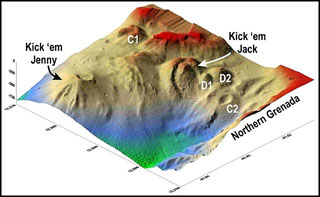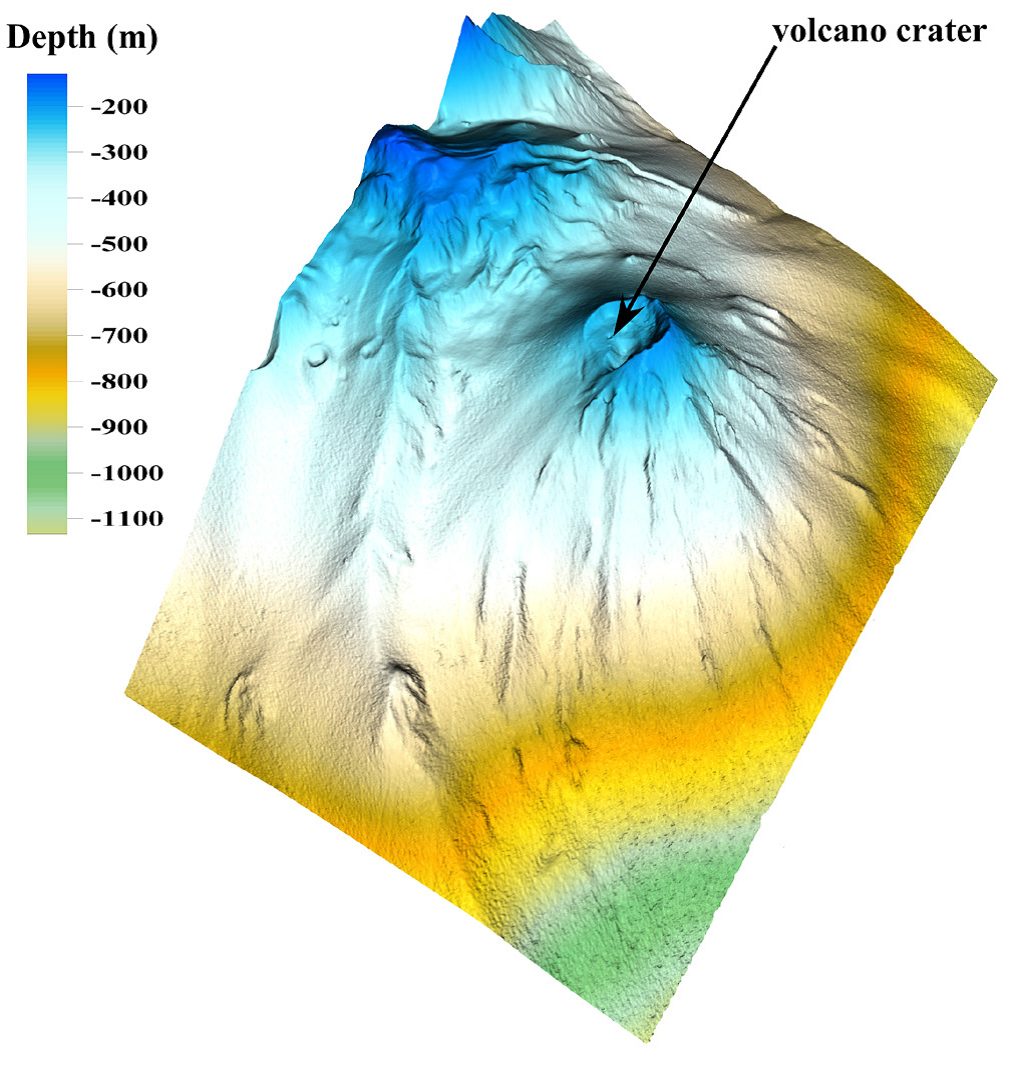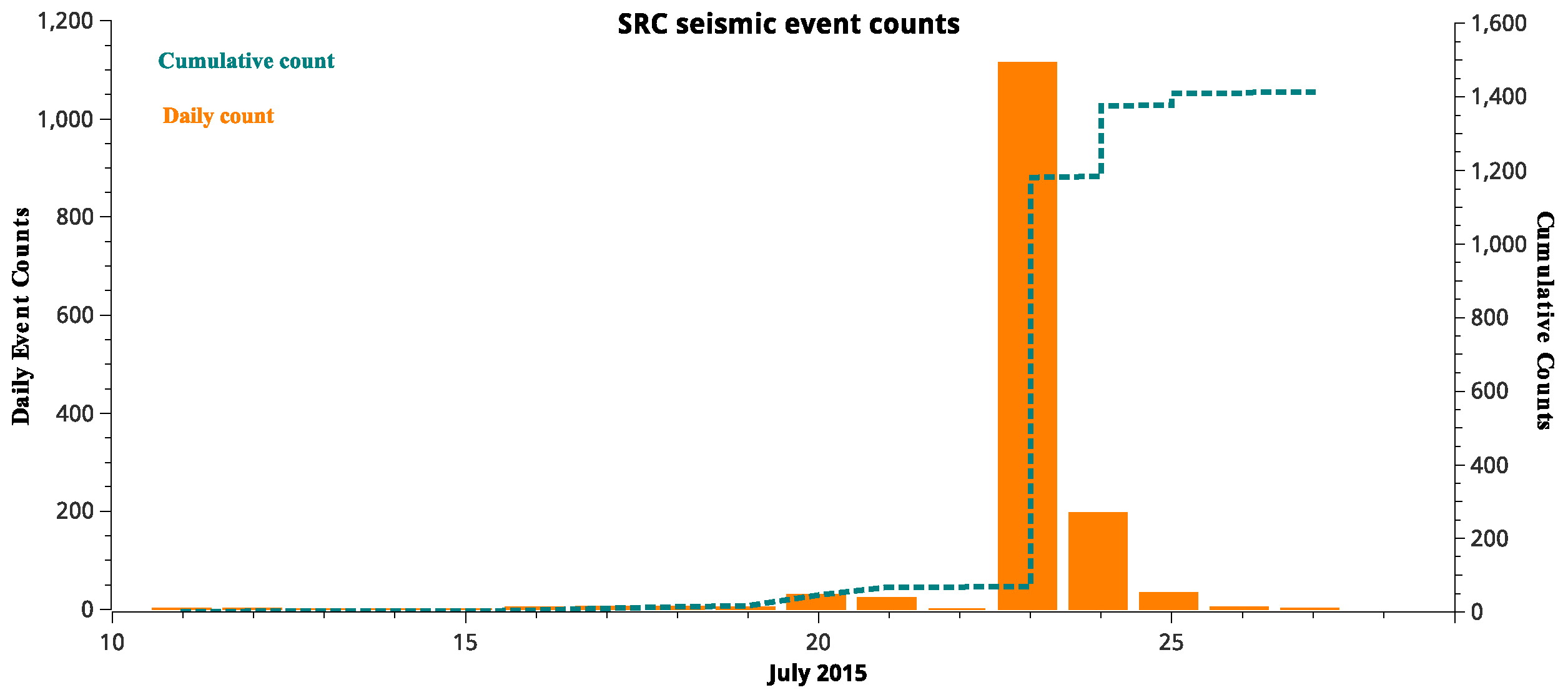Report on Kick 'em Jenny (Grenada) — August 2015
Bulletin of the Global Volcanism Network, vol. 40, no. 8 (August 2015)
Managing Editor: Edward Venzke.
Edited by A. Elizabeth Crafford.
Kick 'em Jenny (Grenada) Two submarine explosions during 23-24 July 2015
Please cite this report as:
Global Volcanism Program, 2015. Report on Kick 'em Jenny (Grenada) (Crafford, A.E., and Venzke, E., eds.). Bulletin of the Global Volcanism Network, 40:8. Smithsonian Institution. https://doi.org/10.5479/si.GVP.BGVN201508-360160
Kick 'em Jenny
Grenada
12.3°N, 61.64°W; summit elev. -185 m
All times are local (unless otherwise noted)
The submarine Kick 'em Jenny volcano, 8 km N of Grenada (figure 8), has erupted 12 times since reporting began in 1939. Typical activity consists of explosions over a few days. Explosions on 23-24 July 2015 were the first since early December 2001 (BGVN 26:11). A report published by the Seismic Research Centre of the University of the West Indies (SRC) (Robertson et al., 2015) has described this most recent eruption.
Unusual seismicity in the vicinity of the volcano was first observed on 11 July 2015. This consisted of elevated numbers of micro and small events recorded at stations in Carriacou and Granada. The daily counts remained low until 16 July and then increased to 23 events on 20 July. By the evening of 22 July, the cumulative count of events was up to 218 (figure 9); all events were estimated to be less than M 3.0.
On 23 July 2015, from about midnight to 1600 local time, the SRC recorded more than 400 events, the largest was M 3.3. Along with the increase in the number and magnitude of seismic events, were 'felt reports' from northern Grenada. At 0142 a strong, continuous signal was recorded on the GCMP and GRGR seismic stations that lasted until about 0258. Strong T-phase signals recorded at seismic stations in Montserrat were interpreted to be an explosion from Kick 'em Jenny. T-phases are acoustic waves generated from an earthquake or underwater explosion that travel through the ocean. The Alert Level was raised to Orange (the second highest level on a 4-color scale) on 23 July, and vessels were instructed to observe an exclusion zone within a 5-km radius of the crater.
At about 0002 on 24 July 2015 the seismic network recorded another hour-long explosion signal. A T-phase signal from this event, also recorded in Montserrat, confirmed the nature of the activity. Following the explosion signal there were at least 89 volcanic earthquakes recorded up to 1600 that afternoon. Afterward, and through the next day, seismicity declined (figure 2).
During an overflight on 25 July, scientists observed no activity at the ocean surface above the volcano. On 26 July the Alert Level was lowered back to Yellow. Optical and radar satellite images of the area during the eruption period did not show any surface disturbances or evidence of a pumice raft in nearby waters. These observations supported the conclusion that no eruptive material broke the surface of the sea and no eruptive activity continued after the seismic activity ended on 24 July.
Reference: Robertson, Richard E. A. Latchman, J.L., Lynch, L., Dondin, F., Ash, C., Camejo, M., Christopher, T., Graham, O., Machel, H., Jackson, V., Joseph, R., Juman, A., Juman, I., Nath, N., Ramsingh, C., Ramsingh, H., Ryan, G., Smith, P., Stewart, R., and Stinton, A., 2015. Report on the 2015 unrest activity at Kick-'em-Jenny submarine volcano, Grenada. Seismic Research Centre, The University of the West Indies, St. Augustine, Trinidad, West Indies. http://www.uwiseismic.com/Downloads/KeJReport2015.pdf
Geological Summary. Kick 'em Jenny, an active submarine volcano 8 km off the N shore of Grenada, rises 1,300 m from the sea floor. Recent bathymetric surveys have shown evidence for a major arcuate collapse structure, which was the source of a submarine debris avalanche that traveled more than 15 km W. Bathymetry also revealed another submarine cone to the SE, Kick 'em Jack, and submarine lava domes to its S. These and subaerial tuff rings and lava flows at Ile de Caille and other nearby islands may represent a single large volcanic complex. Numerous eruptions have occurred since 1939, mostly documented by acoustic signals. Prior to the 1939 eruption, when an eruption cloud rose 275 m above the ocean and was witnessed by a large number of people in northern Grenada, there had been no written mention of the volcano. Eruptions have involved both explosive activity and the quiet extrusion of lava flows and lava domes in the summit crater; deep rumbling noises have sometimes been heard onshore. Recent eruptions have modified the morphology of the summit crater.
Information Contacts: Richard Robertson, Seismic Research Centre (SRC), The University of the West Indies, St. Augustine, Trinidad & Tobago, West Indies (URL: http://www.uwiseismic.com).



